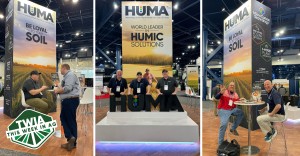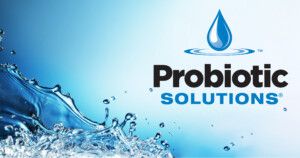Super Phos: Your Most Nutrient-Efficient & Cost-Efficient Source of P
Save 25% Per Pound vs. DAP/MAP
As of right now, prices for DAP and MAP are soaring above $900/ton. This equates to $0.87-0.98/lb P2O5. Each gallon of SUPER PHOS® (0-50-0) is equivalent to 50lbs of P2O5. SUPER PHOS is roughly $37 per gallon. This equates to $0.73/lb P2O5. Freight adds around 5 cents to that calculation. So how do we save 20-25% on phosphorus fertilizer per pound of P2O5?
It all starts with our secret sauce, a unique type of humate called Micro Carbon Technology® (MCT). Being the world leader in humates for over 50 years, and operating two humate mines… we know a thing or two about beneficial carbon. Switching from a salt-based fertilizer to a carbon-based fertilizer has great benefits! The majority of SUPER PHOS (0-50-0) is high-grade Phos Acid plus this MCT base.
MCT is a subfraction of Fulvic Acid, meaning higher molecular surface area and higher exchange capacity. These highly oxygenated carbon rings, complexing with phosphorus, allow us to stay highly bioavailable. SUPER PHOS enters the plant within one hour as a foliar spray, and between 12-24 hours through the roots. This small, carbon carrier itself is a natural biostimulant – a perfect synergy!
MCT also allows us to blend SUPER PHOS with other ingredients that P wouldn’t normally be able to – our CALCIUM(Calcium Nitrate) and Z-MAX® (Zinc, Copper, Manganese, Sulfur), for instance. The MCT that’s in each of these products can block or complex the exchange sites of the nutrients to keep them from reacting with each other and precipitating out. These oxygenated functional groups are showing their chelating/complexing power!
Due to this bioavailability, one gallon of SUPER PHOS weighs 12.44lbs, yet is equivalent to 50lbs of P2O5. But wait, at 50% P2O5 content (0-50-0), it should only give 6.22lbs/gallon of P2O5! It has an increased efficiency of 800%. But let’s first talk about the efficiency of P fertilization in general.
Phosphorus is by far, one of the most inefficient nutrient to get into crops. This is why there is such a buzz about spending so much time and money applying lime and/or sulfur to get the sweet soil pH of 6.5 to improve nutrient (and especially P) availability. Even after all that time, money and effort… only a small portion of the actual P applied will even be plant available, less than 20%. This inefficiency is actually built into the lab’s recommendations at the bottom of your soil sample – expecting a 5-15% efficiency of P fertilizer. Switching to SUPER PHOS, since the crop only needs 15lbs, we can swap with two gallons of SUPER PHOS, which is bioavailable and gets right into the plant. The actual amount of P2O5 that’s being applied is 12.44lbs. But with those two gallons, I can promise that the amount of P that gets into the plant would be way higher than the 200lbs of MAP! Not to mention SUPER PHOS is an “instant release” fertilizer. Apply it today, see results today. Think of it as an IV going directly into the bloodstream.
SUPER PHOS (due to MTC) can be applied to soil and stays in the soil solution, increasing its bioavailability, and resisting its natural tendencies to tie up with Calcium (high pH) or Aluminum and Iron (low pH) in those extreme pH ranges. SUPER PHOS works in all cases, especially showing up to the game even in cold and wet environments when P availability is especially low. Foliar applications are even stronger and more recommended for spoon feeding the crop. A little bit goes a long, long way!
Here are some things to keep in mind while using SUPER PHOS. It is LOADED to the brim and can’t hold much more. So it is super in that regard. There are some caveats with this product. If you blend SUPER PHOS with calcium or Zinc, use Huma’s CALCIUM or Z-MAX products. We know they work! We even manufacture a pre-blend Z-PHOS® and C-PHOS® product. No tank-mix issues with either of these two products. Other manufacturers’ Zinc or Calcium may not work; so always run a jar test or reach out to us for suggestions.
SUPER PHOS’ pH is between 1.0 and 1.5. That’s extremely low. Both a blessing and a curse. If you need a tank-mix conditioner to bring the pH down, SUPER PHOS is the perfect candidate for that situation! On the other hand, cast iron, bronze, brass, and other metals have issues dealing with the extremely low pH. So, we recommend either swapping out those spray tips, hoses, pumps, etc., or applying in smaller doses to keep that equipment running effectively! For drip systems and fertigation equipment, SUPER PHOS plays really well. It even helps clean out precipitates and keeps emitters clean from buildup.
In foliar applications, the effectiveness of SUPER PHOS goes up even higher! However, issues can come from low-volume applications and high concentrations. SUPER PHOS shouldn’t be applied above a 10% concentration. In airplane/drone applications of 3-5 gallons/acre, SUPER PHOS shouldn’t be above 1qt/ac. In typical ground rig applications of 10 gallons/ac, 2qts is plenty. Think about it: this is 25lbs of P2O5 directly into the plant. Be wary of applying more than the crop can metabolize at once. It’s all getting into the plant! Spoon feeding is always recommended over a large dose.
Let’s take a look at our application options outside of fertigation.
1. In-furrow is a popular method, since SUPER PHOS is low volume and buffered vs.
other P sources! Hundreds of research trials show that SUPER PHOS performs
equal to or better than 10-34-0. At less than 10x the rate. Apply up to 2-4qts/ac.
2. Burndown applications or preplant applications work great. Our MCT improves
the efficiency of the herbicide that’s being applied, especially if it is a P-based
herbicide, such as Glyphosate or Glufosinate. Burndown applications, we have
more flexibility since we don’t have to worry about phytotoxicity. Apply 2-4 qts/ac.
3. Post-harvest can be an option. MCT will keep the SUPER PHOS available throughout the next year. Add in a residue management product
like FERTIL HUMUS® to really move the needle! You can put out up to 2 qts.
4. Any side dress applications. Apply up to 2qts/ac.
5. Any other pesticide or fertilizer application up through harvest! Reminder that our
MCT based products, when mixed in the tank, aid in the
uptake of that material! Rates may need to be adjusted due to the carbon
complexing. Apply 1-2qts/ac in each application is a rate.
Regrettably, UAN loves staying basic, so applying SUPER PHOS with UAN isn’t the greatest option, although we do have a few workarounds. Reach out to us with questions or concerns. But with any product, we always, always, recommend a jar test!
SUPER PHOS is the perfect tank-mix partner to add at any stage, especially where P fertilization lacks availability. We’ve seen it successful for over 40 years, in over 40 countries all over the world. Join the growing number of farmers and see the benefits of SUPER PHOS today!
Related Posts

This Week in Ag #71
Farmers are not fast forgetters. They have long memories. Past weather events, cultural practices, product usage, and marketing decisions often drive future decisions. With that, I’m guilty as charged. Last season, a straight-line wind caused major greensnap to a new corn hybrid, wrecking my goals. This made me take pause and return to some of the

This Week in Ag #55
While farmer sentiment may be down, their appetite for new information is not. Initial estimates had last week’s Commodity Classic drawing record crowds, with projections of 11,000 attending the event in Houston.

Breaking Down COD
By Heather Jennings, PE When I first came into the water field in the 2000s, the general rule of Chemical Oxygen Demand to Biochemical Oxygen Demand (or COD to BOD5) was 2:1. That was pretty much all you needed to know in order to understand whether something could be treated chemically, physically, or biologically. Now, the wastewater industry has moved toward COD instead of BOD5. The reason that COD is

